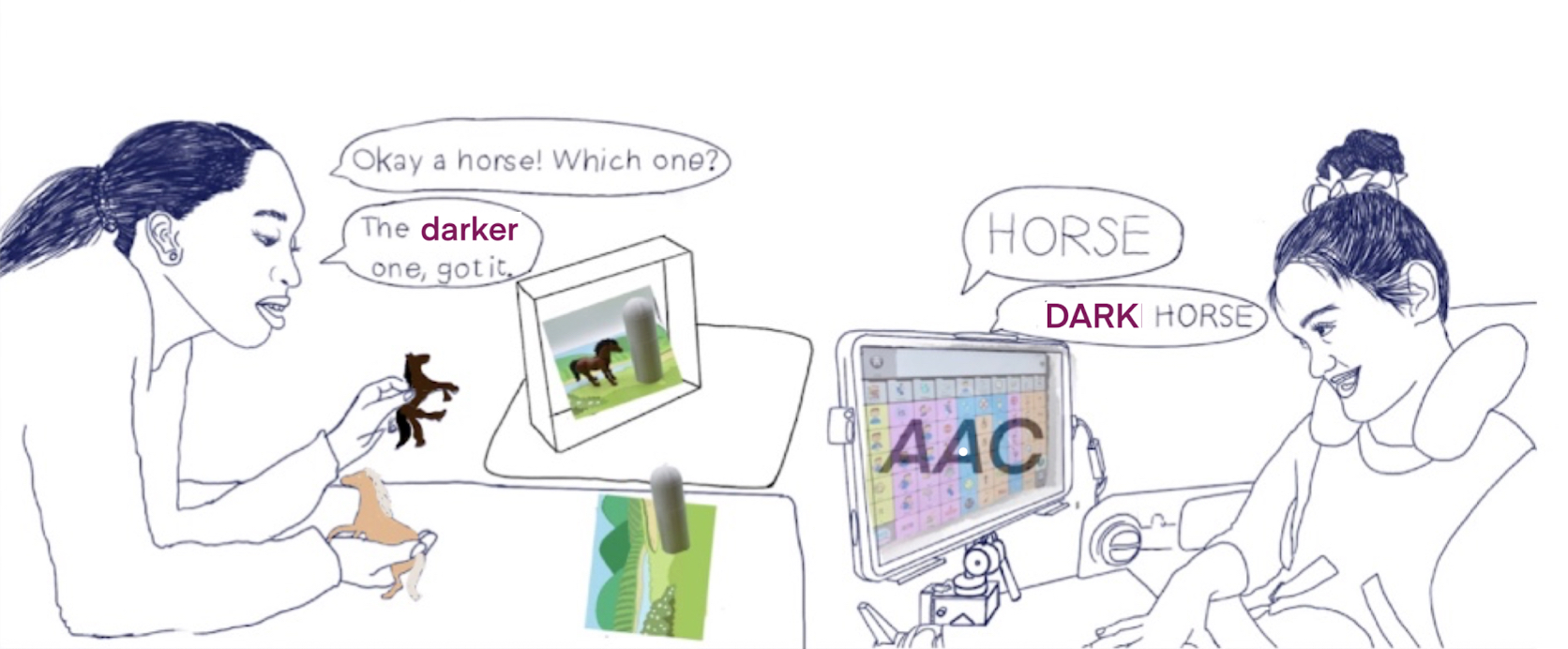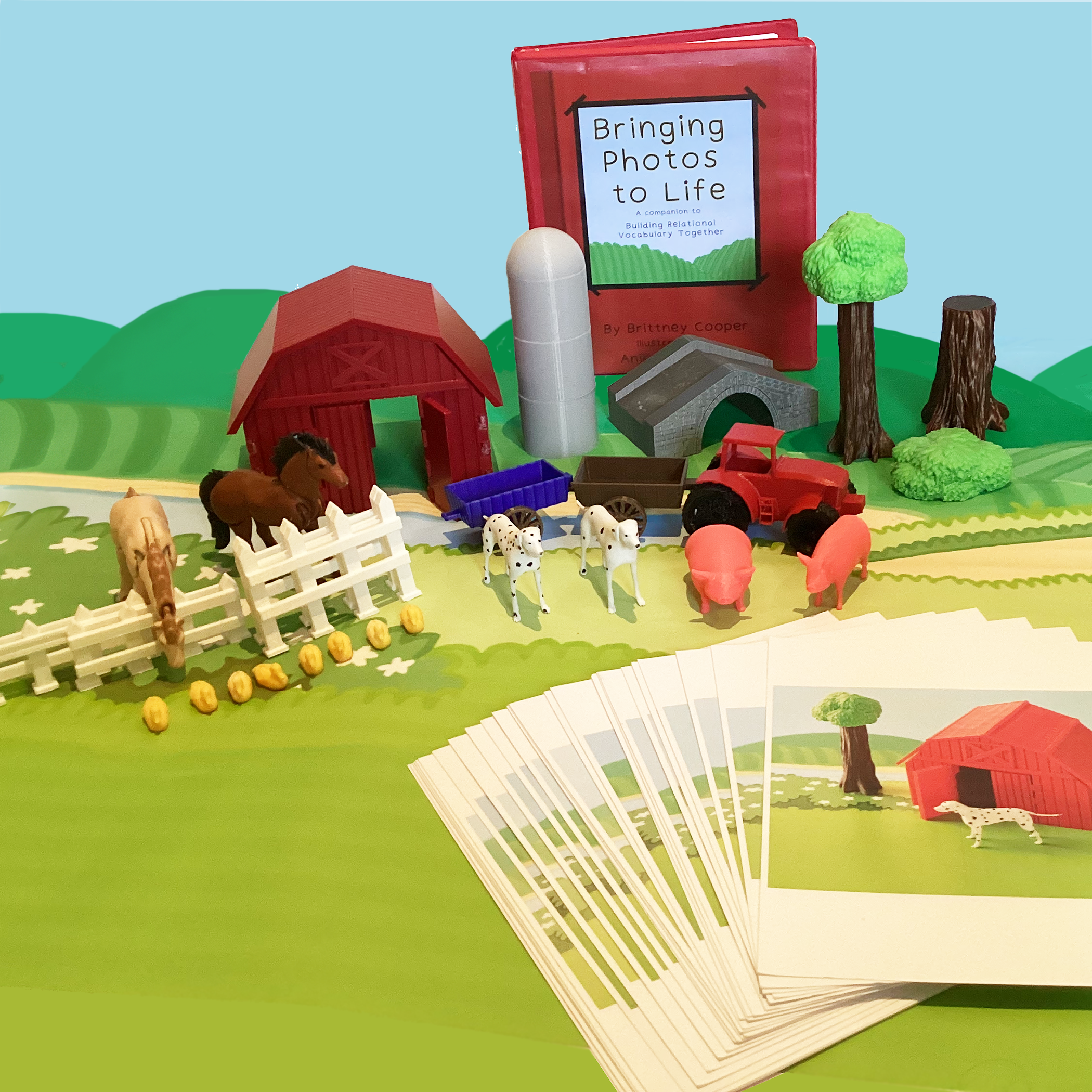Artwork by Anika Nambisan
Child initiates an instruction by producing HORSE on SGD. The partner confirms partial understanding and signals communication breakdown by asking “which one.” The child repairs the breakdown by adding the appropriate relational word: DARK HORSE. The partner recasts the child’s utterance.
Our Solution
Building Relational Vocabulary Together (BRVT) is a pedagogical activity designed to help children with complex communication needs learn and practice using relational vocabulary in the context of a dyadic goal-oriented ‘barrier-game.’ Throughout the activity, participants view a photographed scene and provide their partner with directions so that they can reconstruct the scene without seeing the photographed target. The highly contrastive game materials and construction cards promote ongoing relational judgements in terms of spatial arrangement, sequence, dimension, size, orientation etc.
Relational vocabulary (e.g., spatial (under); temporal (first); dimension (taller); etc.) is critically important for giving directions, communicating unknown information, and participating in social and academic activities. Children with severe motor-speech disorders (e.g., Cerebral Palsy) who use Augmentative and Alternative Communication (AAC) typically have limited opportunities to communicate unknown information and engage in object manipulation. In addition, communication systems for pre-literate children often involve the selection of iconic graphic symbols to produce messages. Differences related to physical manipulation, communication opportunities, and semiotic mode may reduce their experience with relational vocabulary influencing graphic symbol production, graphic symbol comprehension and generalization of meaning/use. Children using AAC may also lack the motor automaticity needed to produce relational vocabulary fluently using their AAC system. BRVT was created in response to a lack of effective strategies and tools for teaching and/or practicing relational vocabulary for this population of aided communicators. BRVT differs from prior language instruction solutions that attempt to teach graphic symbol comprehension/production using non-dialogic and representation-oriented methods. Our solution allows children to guide their own vocabulary learning by providing opportunities for instruction and practice during an “on-line” social interaction with a shared objective.
Team members: Brittney Cooper (Berkeley School of Education, UC Berkeley; Special Education, SFSU); Manooshree Patel (Berkeley School of Education, SESAME); Michael Luu (Mathematics); Anika Nambisan, Pinewood School)
Mentors: Dor Abrahamson (Graduate School of Education, UC Berkeley); Gloria Soto (Speech, Language and Hearing Sciences, Special Education, SFSU)
Funding: We are thankful to the CITRIS Invention Lab and the Jacobs Institute for supporting our project. We are also grateful for funding provided by the UCSF | UC Berkeley Schwab Center for Dyslexia and Cognitive Diversity.
Looking Ahead
We have completed a round of data collection including 6 individual case-study students engaged in the activity with me, serving as clinician–researcher, for up to 10 sessions each. We are in the process of analyzing the 50+ hours of audio/video data we accumulated.
Presentations
Cooper, B., & Soto, G. (2024). The prevalence of relational basic concepts on core vocabulary lists for AAC: is frequency enough?. Augmentative and Alternative Communication, 1-11. https://doi.org/10.1080/07434618.2024.2332648
Cooper, B. (2023, Dec). Building Relational Vocabulary Together, Jacobs Institute for Design Innovation’s Winter Design Showcase, Penn State University. University of California, Berkeley
Cooper, B. (2022, May). Constructing relational concepts: A pedagogical design for students with complex communication needs. Poster presentation, Jacobs Institute for Design Innovation’s Winter Design Showcase, Penn State University. University of California, Berkeley
Cooper, B. (2022, May). Constructing relational concepts: A pedagogical design for students with complex communication needs. Paper presentation, AAC Doctoral Student Think Tank, Penn State University.
Cooper, B. (2022, April). Special-education game-based use of Augmented and Alternative Communication devices (AAC) to learn relational concepts. Poster presentation, Graduate School of Education Research Day, University of California, Berkeley.
Cooper, B. (2022, January). Constructing relational concepts: A pedagogical design for students with complex communication needs. Work in progress roundtable, University of California Research on Special Education, Disabilities and Developmental Risk (UC SPEDDR) Conference, University of California, Riverside, January 21, 2022.
Krause, C.M., Chen, R. S. Y., Tancredi, S., Cooper, B., Foley, E., Anton, J., Kim, J., & Abrahamson, D. (2021, October). Catching up with SpEED: Applying a framework for inclusive equitable learning opportunities through Special Education Embodied Design. Invited workshop, Unimc for Inclusion Settimana dell’inclusione (Inclusion Week), University of Macerata, Italy, October 25, 2021.
Krause, C.M., Chen, R. S. Y., Tancredi, S., Cooper, B., Foley, E., Anton, J., Kim, J., & Abrahamson, D. (2021, October). Catching up with SpEED: Applying a framework for inclusive equitable learning opportunities through Special Education Embodied Design. Invited colloquium talk, Graduate Group in Science and Mathematics Education (SESAME) Colloquium, University of California Berkeley, California, United States, October 21, 2021.


